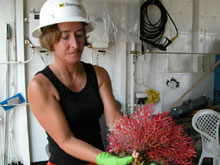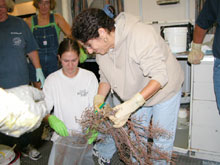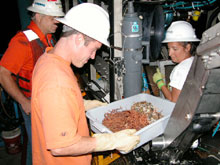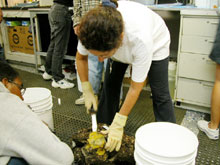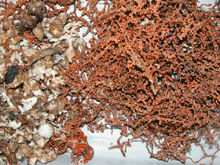
Various sponges and octocorals collected during the 2003 "Deep Sea Medicines" expedition.
![]() Click image to view a slideshow.
Click image to view a slideshow.
'Deep Sea Medicines' Expedition Summary
September 8-19, 2003
John K. Reed
Chief Scientist, Deep Sea Medicines
Senior Scientist, Division of Biomedical Marine Research
Harbor Branch Oceanographic Institution
Amy Wright, PhD
Co-Principal Investigator, Deep Sea Medicines
Director, Division of Biomedical Marine Research
Harbor Branch Oceanographic Institution
Shirley A. Pomponi, PhD
Co-Principal Investigator, Deep Sea Medicines
Vice President and Director of Research
Harbor Branch Oceanographic Institution
The 2003 Deep Sea Medicines expedition was full of firsts. Scientists from the Division of Biomedical Marine Research (DBMR) of Harbor Branch Oceanographic Institution (HBOI) spent 12 days aboard the NOAA Ship Ronald H. Brown successfully documenting deep-water reefs and live-bottom habitats in U.S. Gulf of Mexico waters. Although previous geological studies surveyed some of these sites, virtually nothing was known about their biology and biodiversity. This was also the first time that the NOAA Office of Ocean Exploration collaborated with Sonsub Inc. to use an industrial ROV (remotely operated vehicle) to conduct exploratory research.
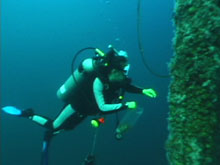
While the ROV collected deep-water samples around one oil platform, scientists donned scuba gear and dove in shallow water around a second one. Click image for larger view.
The primary objective of this expedition was to explore marine habitats in search of organisms possessing bioactive compounds with potential as pharmaceutical products or biomedical research tools. Research into these compounds may, in the long term, result in the development of drugs to treat cancer, infectious diseases, disorders of the immune and central nervous systems, and cardiovascular disease.
During the expedition, 22 ROV dives and one scuba dive were completed. Twelve sites were documented with 87.7 hrs of ROV dive time and 5 hrs of scuba diving. Dive sites included (1) shelf-edge paleoshorelines along the southwest Florida shelf, northwest Florida shelf (Madison and Swanson marine protected area and the Twin Ridges), and the Alabama shelf (The Pinnacles); (2) deep-water Lophelia coral lithoherms off the soutwestern Florida slope and Alabama shelf slope; and (3) three oil platforms off the Mississippi Delta.
A total of 155 samples of benthic macrofauna and environmental samples were collected and catalogued, and will be used for biomedical research and taxonomic studies. At five sites, a SEABEAM (multibeam) map was made prior to the dives: (1) On Sept. 11, 2003, southewest Florida shelf, 1988 trawl site, 250 ft depth; (2) On Sept. 11, 2003, southwest Florida shelf, lithoherm site, 1,827 ft depth; (3) On Sept. 13, 2003, northwest Florida shelf, Twin Ridges, 243 ft depth; (4) On Sept. 14, 2003, northwest Florida shelf, Madison and Swanson MPA, 270 ft depth; and (5) On Sept. 17, 2003, southern Alabama shelf, Mississippi Canyon Block 118, 3,000 ft depth.
Benthic macrofauna and habitats were documented with approximately 69 hrs of videotape, 585 underwater and 255 shipboard digital still images, and 155 specimens of sponges, octocorals, scleractinian corals, crustaceans, echinoderms, and environmental samples. Initial taxonomic analyses indicated that some sponges and gorgonians may be species new to science, and some may be range extensions. Further work in collaboration with specialists will be conducted to verify these preliminary determinations. The road toward discovering new lifesaving pharmaceuticals is long, and has only just begun.
Key Findings
A deep-water Lophelia coral lithoherm off the southwest Florida slope was documented for the first time with a high-definition topographic SEABEAM map, ROV dives, and videotapes. This site was first documented from seismic profiles and bottom dredge samples (Newton et al., 1987). Thickets of live and dead Lophelia coral were discovered on top of the pinnacles.
At five sites, a SEABEAM (multibeam) map was made prior to the dives: (1) On Sept. 11, 2003, southewest Florida shelf, 1988 trawl site, 250 ft depth; (2) On Sept. 11, 2003, southwest Florida shelf, lithoherm site, 1,827 ft depth; (3) On Sept. 13, 2003, northwest Florida shelf, Twin Ridges, 243 ft depth; (4) On Sept. 14, 2003, northwest Florida shelf, Madison and Swanson MPA, 270 ft depth; and (5) On Sept. 17, 2003, southern Alabama shelf, Mississippi Canyon Block 118, 3,000 ft depth.
A total of 155 samples were collected, including 68 cnidaria, 60 porifera, 5 mollusca, 4 bryozoa, 3 annelida, 2 ascidiacea, 1 sipunculida, 1 sipunculida, and 7 environmental samples (water, rocks, sediment).
Taxonomy of invertebrates is ongoing and new species or new records of occurrence will be documented.
Chemical profiles of extracts made from specimens of sponges and octocorals indicate that novel compounds are present in several samples. Biochemical testing of samples is ongoing.
Several species exhibited antimicrobial activity, as determined by the shipboard disk diffusion assays. Microbial research is ongoing.
Education and Outreach: The NOAA Office of Ocean Exploration's national education coordinator and HBOI's media lab videographer provided a strong educational component to the mission, including the development of lesson plans for grades 6-12, interviews, and post-cruise presentations. Other education and outreach products included the transmittal and posting of daily logs and images on the NOAA Ocean Explorer Web site, and the hosting of an educator-at-sea who shared his experiences at sea with his students.
Media Coverage included pre- and post-cruise media events, regional TV coverage, and publications. A highlights videotape was developed with potential distribution to national markets. Other expedition-related coverage included: (1) NASA Oceanography Outreach and OceanAge Project, Sept. 3, 2003 -- Andrea McCurdy interviewed HBOI scientists John K. Reed and Dr. Shirley Pomponi for the NOAA Ocean Explorer Web site; (2) National Public Radio, Sept. 5, 2003 -- Broadcaster Jill Roberts interviewed HBOI scientist John K. Reed for "The Florida Environment"; (3) An article in the St. Petersburg Times, Sept. 5, 2003; (4) An article in the Environmental News Network, Sept. 5, 2003; (5) An article in Ascribe, the Public Interest Newsletter, Sept. 5, 2003; (6) A port call, St. Petersburg, FL, Sept. 8, 2003, included a dockside media event, live TV and interviews with PIs Amy Wright and Shirley Pomponi; (7) An article in the Washington Letter of Oceanography, vol. 37, no. 19, Sept. 15, 2003; and (8) An article in the Naples News, Sept. 28, 2003.
Although no plans currently exist to designate any of the areas we explored as MPAs, they are incredibly diverse and irreplaceable resources. Many of the sea-floor structures we observed may be tens of thousands of years old, as evidenced from previous carbon dating of Lophelia coral debris. This type of coral grows slowly, averaging only 10-20 mm/year, and is certainly fragile. Any activities involving bottom dredging, trawling, pipeline laying, or oil/gas production could negatively impact these reefs.
The samples collected during this expedition are certain to contain novel compounds that will show promising biological and therapeutic potential. For HBOI scientists, the discovery of such compounds is the first step on the often arduous road to developing new pharmaceuticals. This "Deep Sea Medicines" expedition has helped pave the way for the exploration, discovery, understanding and preservation of new habitats and resources with the potential to increase the health, well-being, and longevity of humankind.
Sign up for the Ocean
Explorer E-mail Update List.






















